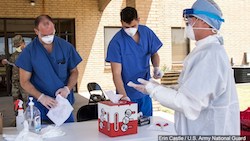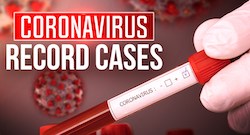Expert warns U.S. cities could face ‘apocalyptic’ future as country sets record for new Covid-19 cases in one day
By Jessica Corbett CommonDreams.org | Last updated: Jun 30, 2020 - 11:06:31 AMWhat's your opinion on this article?
Some U.S. cities and states have slowed or halted plans to ease restrictions enacted in response to the ongoing coronavirus pandemic as the country continues to shatter records in terms of confirmed Covid-19 cases and public health experts warn of what the future could hold.
Texas Republican Gov. Greg Abbott announced a temporary pause in the state’s reopening process on June 25 amid rising infections, a move that critics called “too little, too late.” Austin, Dallas, Houston, and San Antonio are all seeing rising case numbers.

“The big metro areas seem to be rising very quickly and some of the models are on the verge of being apocalyptic,” Dr. Peter Hotez, dean of the National School of Tropical Medicine at the Baylor College of Medicine, told CNN recently, citing models that show Houston could see a four-fold spike in daily cases by July 4.
“That is really worrisome and as those numbers rise, we’re seeing commensurate increases in the number of hospitalizations and ICU admissions,” added Dr. Hotez, who is also working on a potential vaccine for Covid-19. “You get to the point where you overwhelm ICUs and that’s when the mortality goes up.”
On a national level, there was a record number of about 40,000 new Covid-19 cases on June 25, according to the Johns Hopkins University global tracker. The last record was set on April 24 at 36,400, though the U.S. saw new infections nearly at that level on June 23 and June 24.

The rise in U.S. cases, as Common Dreams reported June 25, comes as countries with socialized healthcare systems are seeing their infection numbers decline.
As of the morning of June 26, the U.S. death toll had topped 124,500 and the number of total confirmed cases nationwide was over 2.4 million—more than any other country in the world—though public health experts warn the infection rate could be much higher.
“Our best estimate right now is that for every case that’s reported, there actually are 10 other infections,” Robert Redfield, director of the Centers for Disease Control and Prevention (CDC), said in a call with reporters June 25—meaning that over 24 million Americans could actually be infected with the virus.
That estimate is based on blood samples tested for the presence of antibodies to the virus, Redfield explained. NBC News reported that the samples are from people who have specifically sought antibody testing as well as those who have donated blood or had laboratory testing of blood for other reasons.
“This virus causes so much asymptomatic infection,” added Dr. Redfield, who reiterated the importance of social distancing, wearing a face mask in public, and handwashing. “The traditional approach of looking for symptomatic illness and diagnosing it obviously underestimates the total amount of infections.”
The New York Times tracking system put the number of new Covid-19 cases in the United States on June 25 above 41,000. The Times also reported June 25 on the rising number of adults in their 20s, 30s, and 40s with confirmed infections in some places of the country where the case numbers are surging, pointing to Arizona, Florida, and Texas as examples.
“What is clear is that the proportion of people who are younger appears to have dramatically changed,” Joseph McCormick, a professor of epidemiology at UTHealth School of Public Health in Brownsville, told the Times. “It’s really quite disturbing.”
According to the newspaper: The pattern is drawing notice from mayors, governors, and public health officials, and comes as a worrisome sign for cities and institutions as they look to the fall. The rise in cases among younger people could complicate the plans of leaders who are eager to open schools and universities, resume athletic events, and return to normal life and a fully functioning economy.
The increases could reflect a simple reality: Since many states have reopened bars, restaurants and offices, the coronavirus has been allowed to spread more widely across communities, including to more young people. But people in their 20s and 30s are also more likely to go out socializing, experts say, raising concerns that asymptomatic young people are helping to spread the virus to more vulnerable Americans at a time when cases are surging dangerously in the South and the West.
The University of Washington’s Institute for Health Metrics and Evaluation (IHME) on June 24 released a model showing that nearly 180,000 people in the United States will die because of Covid-19 by October 1. The researchers also projected the U.S. death toll would drop to about 146,000 if at least 95 percent of people wore masks in public.
“There is no doubt that even as states open up, the United States is still grappling with a large epidemic on a course to increase beginning in late August and intensifying in September,” IHME director Dr. Christopher Murray said in a statement. “People need to know that wearing masks can reduce transmission of the virus by as much as 50 percent, and those who refuse are putting their lives, their families, their friends, and their communities at risk.”
New ABC News/Ipsos polling released June 26 shows that 87 percent of Americans have worn a face mask or covering when leaving home in the past week, up from 61 percent in April. The poll also found that 56 percent of Americans believe the economy is reopening too quickly and 76 percent of Americans are now concerned about contracting the virus, which is up from 69 percent in early June and reverses a two-month declining trend since April.
The survey, which also showed that Americans’ willingness to go out in public for various activities has fallen in the past two weeks as cases across the country have surged, was conducted June 24 and June 25 and its margin of sampling error is plus or minus 4.7 percentage points.
The White House Coronavirus Task Force on June 26 held its first public briefing in nearly two months. The live-streamed event was held at the Department of Health and Human Services rather than the White House and was led by Vice President Mike Pence, who heads the task force.
INSIDE STORIES AND REVIEWS
-
-
About Harriett ... and the Negro Hollywood Road Show
By Rabiah Muhammad, Guest Columnist » Full Story -
Skepticism greets Jay-Z, NFL talk of inspiring change
By Bryan 18X Crawford and Richard B. Muhammad The Final Call Newspaper @TheFinalCall » Full Story -
The painful problem of Black girls and suicide
By Charlene Muhammad -National Correspondent- » Full Story -
Exploitation of Innocence - Report: Perceptions, policies hurting Black girls
By Charlene Muhammad -National Correspondent- » Full Story -
Big Ballin: Big ideas fuel a father’s Big Baller Brand and brash business sense
By Bryan Crawford -Contributing Writer- » Full Story






 Click Here Stay Connected!
Click Here Stay Connected!








